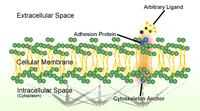
Photo from wikipedia
The Nernst potential of the support/cell interface is suspected to play a key role in cell adhesion and proliferation. However, the studies that have addressed this topic have generally varied… Click to show full abstract
The Nernst potential of the support/cell interface is suspected to play a key role in cell adhesion and proliferation. However, the studies that have addressed this topic have generally varied the electrochemical potential of the interface by comparing different materials or by varying the chemical composition of the surface coating. It is consequently hard to definitively separate the actual effect of the potential from possible side-effects due to differences in the surface composition or topography. Here, a 3-electrode set-up was used to apply different values of potential to identical carbon electrodes. Potentials were applied in the range -200 to 400 mV vs. silver pseudo-reference (SPR), i.e. 90 to 690 mV/SHE, to screen-printed carbon electrodes used to grow Vero or Raw 264.7 cell lines. Values up to 200 mV/SPR prohibited cell adhesion and even caused detachment of cells that were previously adhered. The value of 400 mV/DRP allowed cell adhesion and proliferation, leading to confluent and sometimes very compact mats. The zero charge potential, measured around 200 mV/DRP, showed that the drastic effect of the applied potential was probably due to the negative/positive switch of the surface charge.
Journal Title: Bioelectrochemistry
Year Published: 2021
Link to full text (if available)
Share on Social Media: Sign Up to like & get
recommendations!